Sixteen UW–Madison researchers — including emeritus professor of physics Clint Sprott — were recently recognized on the Institute for Scientific Information™ list of Highly Cited Researchers 2022. The list identifies scientists and social scientists who have demonstrated significant influence through publication of multiple highly-cited papers during the last decade.
News Archives
Department of Energy grant to train students at the interface of high energy physics and computer science
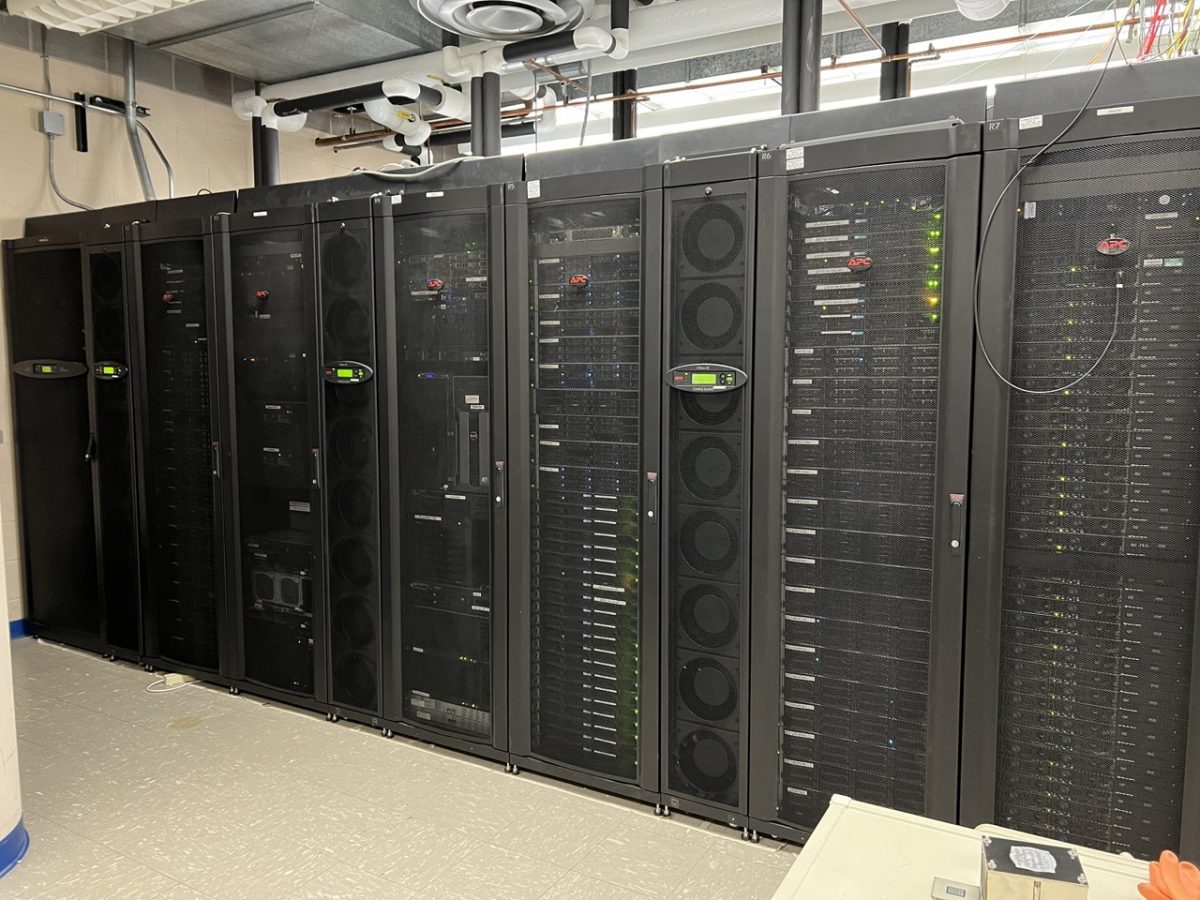
To truly understand our physical world, scientists look to the very small, subatomic particles that make up everything. Particle physics generally falls under the discipline of high energy physics (HEP), where higher and higher energy collisions — tens of teraelectronvolts, or about ten trillion times the energy of visible light — lead to the detection and characterization of particles and how they interact.
These collisions also lead to the accumulation of inordinate amounts of data, and HEP is increasingly becoming a field where researchers must be experts in both particle physics and advanced computing technologies. HEP graduate students, however, rarely enter graduate school with backgrounds in both fields.
Physicists from UW–Madison, Princeton University, and the University of Massachusetts-Amherst are looking to address the science goals of the HEP experiments by training the next generation of software and computing experts with a 5-year, ~$4 million grant from the U.S. Department of Energy (DOE) Office of Science, known as Training to Advance Computational High Energy Physics in the Exascale Era, or TAC-HEP.
“The exascale era is upon us in HEP and the complexity, computational needs and data volumes of current and future HEP experiments will increase dramatically over the next few years. A paradigm shift in software and computing is needed to tackle the data onslaught,” says Tulika Bose, a physics professor at UW–Madison and TAC-HEP principal investigator. “TAC-HEP will help train a new generation of software and computing experts who can take on this challenge head-on and help maximize the physics reach of the experiments.”
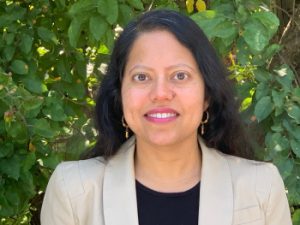
In total, DOE announced $10 million in funding today for three projects providing classroom training and research opportunities in computational high energy physics to train the next generation of computational scientists and engineers needed to deliver scientific discoveries.
At UW–Madison, TAC-HEP will annually fund four-to-six two-year training positions for graduate students working on a computational HEP research project with Bose or physics professors Keith Bechtol, Kevin Black, Kyle Cranmer, Sridhara Dasu, or Brian Rebel. Their research must broadly fit into the categories of high-performance software and algorithms, collaborative software infrastructure, or hardware-software co-design.
Bose’s research group, for example, focuses on proton-proton collisions in the Compact Muon Solenoid (CMS) at the CERN Large Hadron Collider (LHC). The high luminosity run of the LHC, starting in 2029, will bring unprecedented physics opportunities — and computing challenges, challenges that TAC-HEP graduate students will tackle firsthand.
“The annual data volume will increase by 30 times while the event reconstruction time will increase by nearly 25 times, requiring modernization of the software and computing infrastructure to handle the demands of the experiments,” Bose says. “Novel algorithms using modern hardware and accelerators, such as Graphics Processing Units, or GPUs, will need to be exploited together with a transformation of the data analysis process.”
TAC-HEP will incorporate targeted coursework and specialized training modules that will enable the design and development of coherent hardware and software systems, collaborative software infrastructure, and high-performance software and algorithms. Structured R&D projects, undertaken in collaboration with DOE laboratories (Fermilab and Brookhaven National Lab) and integrated within the program, will provide students from all three participating universities with hands-on experience with cutting-edge computational tools, software and technology.
The training program will also include student professional development including oral and written science communication and cohort-building activities. These components are expected to help build a cohort of students with the goal of increasing recruitment and retention of a diverse group of graduate students.
“Future high energy physics discoveries will require large accurate simulations and efficient collaborative software,” said Regina Rameika, DOE Associate Director of Science for High Energy Physics. “These traineeships will educate the scientists and engineers necessary to design, develop, deploy, and maintain the software and computing infrastructure essential for the future of high energy physics.
UW–Madison physicists key in revealing neutrinos emanating from galactic neighbor with a gigantic black hole
On Earth, billions of subatomic particles called neutrinos pass through us every second, but we never notice because they rarely interact with matter. Because of this, neutrinos can travel straight paths over vast distances unimpeded, carrying information about their cosmic origins.
Although most of these aptly named “ghost” particles detected on Earth originate from the Sun or our own atmosphere, some neutrinos come from the cosmos, far beyond our galaxy. These neutrinos, called astrophysical neutrinos, can provide valuable insight into some of the most powerful objects in the universe.
For the first time, an international team of scientists has found evidence of high-energy astrophysical neutrinos emanating from the galaxy NGC 1068 in the constellation Cetus.
The detection was made by the National Science Foundation-supported IceCube Neutrino Observatory, a 1-billion-ton neutrino telescope made of scientific instruments and ice situated 1.5-2.5 kilometers below the surface at the South Pole.
These new results, to be published tomorrow (Nov. 4, 2022) in Science, were shared in a presentation given today at the Wisconsin Institute for Discovery.
“One neutrino can single out a source. But only an observation with multiple neutrinos will reveal the obscured core of the most energetic cosmic objects,” says Francis Halzen, a University of Wisconsin–Madison professor of physics and principal investigator of the IceCube project. “IceCube has accumulated some 80 neutrinos of teraelectronvolt energy from NGC 1068, which are not yet enough to answer all our questions, but they definitely are the next big step toward the realization of neutrino astronomy.”
For the full story, please visit https://news.wisc.edu/uw-madison-scientists-and-staff-key-in-revealing-neutrinos-emanating-from-galactic-neighbor-with-a-gigantic-black-hole/
Shimon Kolkowitz promoted to Associate Professor
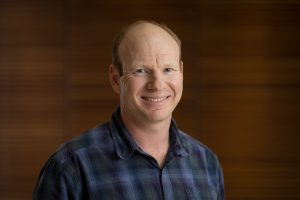
Congratulations to Shimon Kolkowitz on his promotion to Associate Professor of Physics with tenure! Professor Kolkowitz is an AMO physicist whose research focuses on ultraprecise atomic clocks and nitrogen vacancy (NV) centers in diamonds, both of which have applications in quantum sensing. He joined the UW–Madison physics faculty as an assistant professor in January 2018. Since then, he has published numerous articles in top journals, including incredibly accurate comparisons of the rate that clocks run this year in the journal Nature.
Department Chair Mark Eriksson emphasizes Kolkowitz’s contributions across all aspects of his work: “Shimon, graduate students, and postdocs here at Wisconsin, have set records with their atomic clock, and at the same time, Shimon has played critically important roles in teaching and service, including guiding our graduate admissions through the pandemic and all that entails.”
Kolkowitz has been named a Packard Fellow, a Sloan Fellow, and has earned an NSF CAREER award, amongst other honors. He is also the Education, Workforce Development, and Outreach Major Activities Lead for Hybrid Quantum Architectures and Networks (HQAN), an NSF QLCI Institute of which UW–Madison is a member.
IceCube analysis indicates there are many high-energy astrophysical neutrino sources
This story was originally published by WIPAC
Back in 2013, the IceCube Neutrino Observatory—a cubic-kilometer neutrino detector embedded in Antarctic ice—announced the first observation of high-energy (above 100 TeV) neutrinos originating from outside our solar system, spawning a new age in astronomy. Four years later, on September 22, 2017, a high-energy neutrino event was detected coincident with a gamma-ray flare from a cosmic particle accelerator, a blazar known as TXS 0506+056. The coincident observation provided the first evidence for an extragalactic source of high-energy neutrinos.
The identification of this source was possible thanks to IceCube’s real-time high-energy neutrino alert program, which notifies the community of directions and energies of individual neutrinos that are most likely to have come from astrophysical sources. These alerts trigger follow-up observations of electromagnetic waves from radio up to gamma-ray, aimed at pinpointing a possible astrophysical source of high-energy neutrinos. However, the sources of the vast majority of the measured diffuse flux of astrophysical neutrinos still remain a mystery, as do how many of those sources exist. Another mystery is whether the neutrino sources are steady or variable over time and, if variable, whether they vary over long or short time scales.
In a paper recently submitted to The Astrophysical Journal, the IceCube Collaboration presents a follow-up search that looked for additional, lower-energy events in the direction of the high-energy alert events. The analysis looked at low- and high-energy events from 2011-2020 and was conducted to search for the coincidence in different time scales from 1,000 seconds up to one decade. Although the researchers did not find an excess of low-energy events across the searched time scales, they were able to constrain the abundance of astrophysical neutrino sources in the universe.
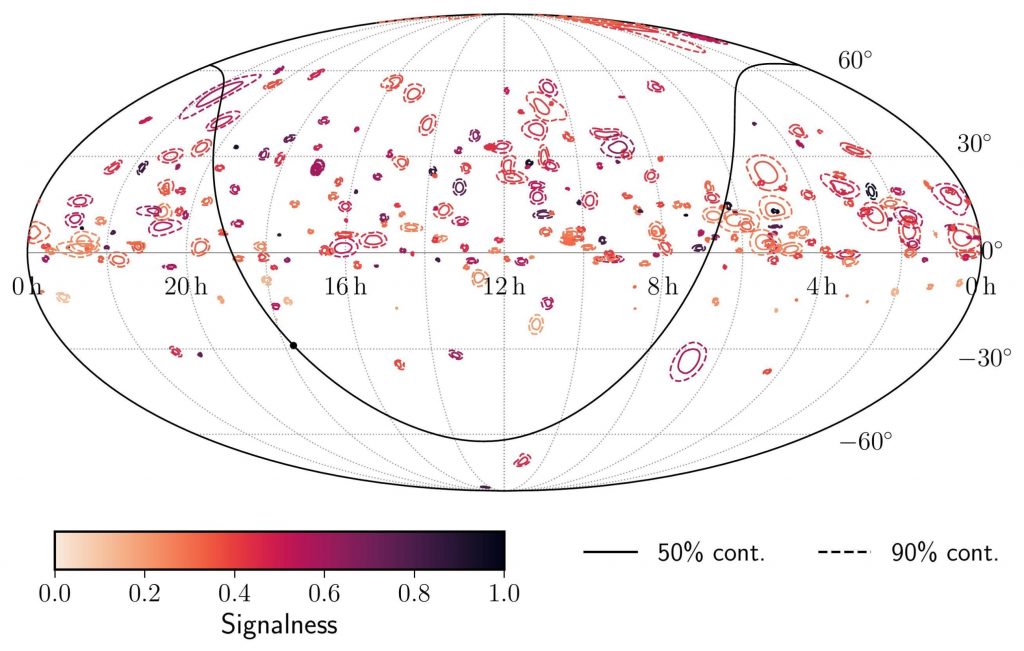
This research also delves into the question of whether the astrophysical neutrino flux measured by IceCube is produced by a large number of weak sources or a small number of strong sources. To distinguish between the two possibilities, the researchers developed a statistical method that used two different sets of neutrinos: 1) alert events that have a high probability of being from an astrophysical source and 2) the gamma-ray follow-up (GFU) sample, where only about one to five out of 1,000 events per day are astrophysical.
“If there are a lot of GFU events in the direction of the alerts, that’s a sign that neutrino sources are producing a lot of detectable neutrinos, which would mean there are only a few, bright sources,” explained recent UW–Madison PhD student Alex Pizzuto, a lead on the analysis who is now a software engineer at Google. “If you don’t see a lot of GFU events in the direction of alerts, this is an indication of the opposite, that there are many, dim sources that are responsible for the flux of neutrinos that IceCube detects.”
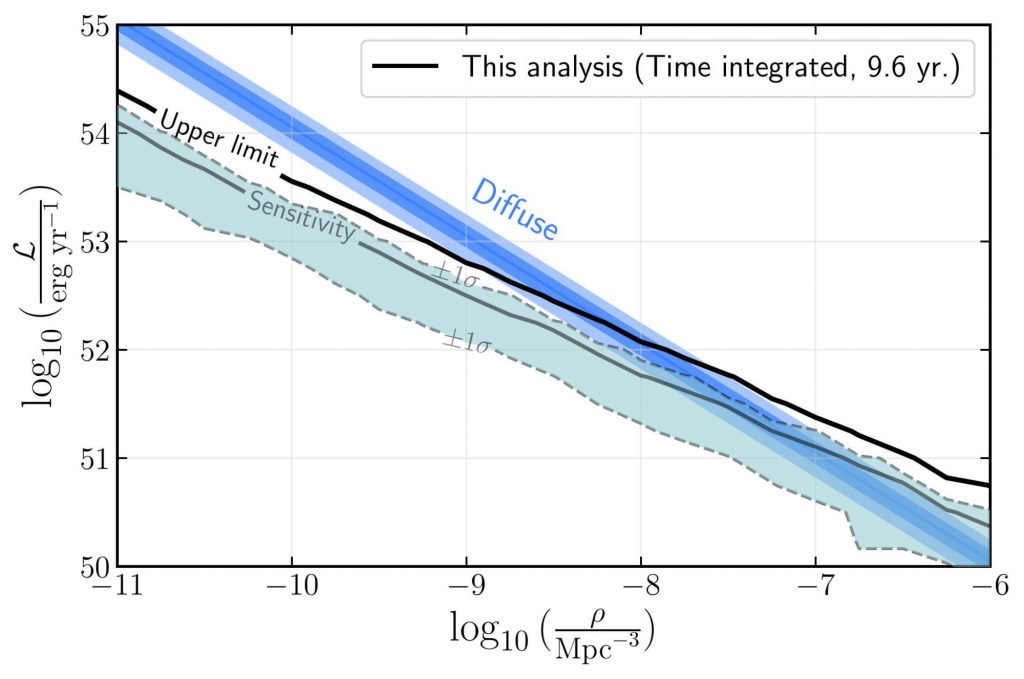
They interpreted the results using a simulation tool called FIRESONG, which looks at populations of neutrino sources and calculates the flux from each of these sources. The simulation was then used to determine if the simulated sources might be responsible for producing a neutrino event.
“We did not find a clear excess of low-energy events associated with the high-energy alert events on any of the three time scales we analyzed,” said Justin Vandenbroucke, a physics professor at UW–Madison and colead of the analysis. “This implies that there are many astrophysical neutrino sources because, if there were few, we would detect additional events accompanying the high-energy alerts.”
Future analyses will take advantage of larger IceCube data sets and higher quality data from improved calibration methods. With the completion of the larger next-generation telescope, IceCube-Gen2, researchers will be able to detect even more dim neutrino sources. Even knowing the abundance of sources could provide important constraints on the identity of the sources.
“The future is very exciting as this analysis shows that planned improvements might reveal more astrophysical sources and populations,” said Abhishek Desai, postdoctoral fellow at UW–Madison and co-lead of the analysis. “This will be due to better event localization, which is already being studied and should be optimized in the near future.”
+ info “Constraints on populations of neutrino sources from searches in the directions of IceCube neutrino alerts,” The IceCube Collaboration: R. Abbasi et al. Submitted to The Astrophysical Journal. arxiv.org/abs/2210.04930.
Alex Levchenko, Mark Rzchowski elected Fellows of the American Physical Society
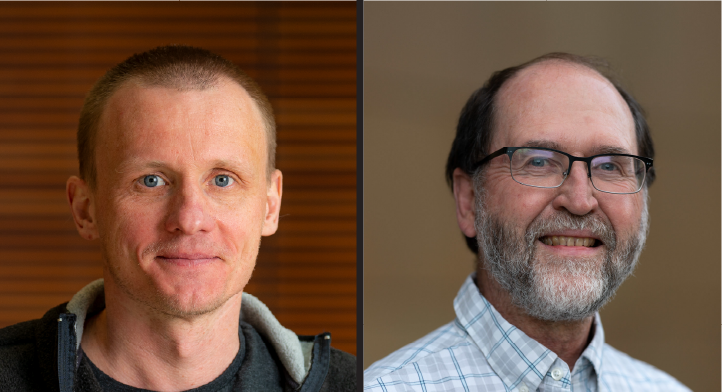
Congratulations to Profs. Alex Levchenko and Mark Rzchowski, who were elected 2022 Fellows of the American Physical Society!
Levchenko was elected for “broad contributions to the theory of quantum transport in mesoscopic, topological, and superconducting systems.” He was nominated by the Division of Condensed Matter Physics.
Rzchowski was elected for “pioneering discoveries and understanding of physical principles governing correlated complex materials and interfaces, including superconductors, correlated oxide systems multiferroic systems, and spin currents in noncollinear antiferromagnets.” He was nominated by the Division of Materials Physics.
APS Fellowship is a distinct honor signifying recognition by one’s professional peers for outstanding contributions to physics. Each year, no more than one half of one percent of the Society’s membership is recognized by this honor.
See the full list of 2022 honorees at the APS Fellows archive.
Decades of work at UW–Madison underpin discovery of corona protecting Milky Way’s neighboring galaxies
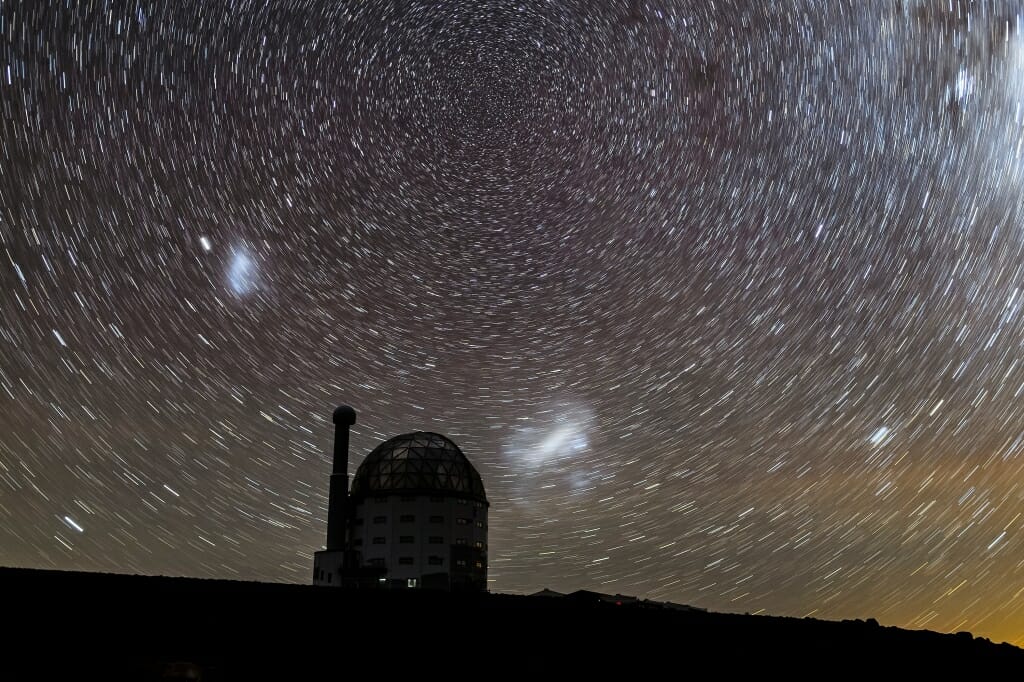
This story was originally posted by UW–Madison News
Two dwarf galaxies circling our Milky Way, the Large and Small Magellanic Clouds, are losing a trail of gaseous debris called the Magellanic Stream. New research shows that a shield of warm gas is protecting the Magellanic Clouds from losing even more debris — a conclusion that caps decades of investigation, theorizing and meticulous data-hunting by astronomers working and training at the University of Wisconsin–Madison.
The findings, published recently in the journal Nature, come courtesy of quasars at the center of 28 distant galaxies. These extremely bright parts of galaxies shine through the gas that forms a buffer, or corona, that protects the Magellanic Clouds from the pull of the Milky Way’s gravity.
“We use a quasar as a light bulb,” says Bart Wakker, senior scientist in UW–Madison’s Astronomy Department. “If there is gas at a certain place between us and the quasar, the gas will produce an absorption line that tells us the composition of the clouds, their velocity and the amount of material in the clouds. And, by looking at different ions, we can study the temperature and density of the clouds.”
The temperature, location and composition — silicon, carbon and oxygen — of the gases that shadow the passing light of the quasars are consistent with the gaseous corona theorized in another study published in 2020 by UW–Madison physics graduate student Scott Lucchini, Astronomy professors Elena D’Onghia and Ellen Zweibel and UW–Madison alumni Andrew Fox and Chad Bustard, among others.
That work explained the expected properties of the Magellanic Stream by including the effects of dark matter: “The existing models of the formation of the Magellanic Stream are outdated because they can’t account for its mass,” Lucchini said in 2020.
“Our first Nature paper showed the theoretical developments, predicting the size, location and movement of the corona’s gases,” says Fox, now an astronomer at the Space Telescope Science Institute and, with Lucchini, a co-author of both studies.
The new discovery is a collaboration with a team that includes its own stream of former UW–Madison researchers pulled out into the world through the 1990s and 2000s — former graduate students Dhanesh Krishnarao, who is leading the work and is now a professor at Colorado College, David French, now scientist at the Space Telescope Science Institute, and Christopher Howk, now a professor at the University of Notre Dame — and former UW–Madison postdoctoral researcher Nicolas Lehner, also a Notre Dame professor.
UW–Madison research leading to the new discovery dates back at least to an inkling of hot gases seen in a study of stars in the Magellanic Cloud published in 1980 by the late astronomy professor Blair Savage and his then-postdoc Klaas de Boer.
“All that fell into place to allow us to look for data from the Hubble Space Telescope and a satellite called the Far Ultraviolet Spectroscopic Explorer, FUSE — which UW also played an important role in developing,” Wakker says. “We could reinterpret that old data, collected for many different reasons, in a new way to find what we needed to confirm the existence of a warm corona around the Magellanic Clouds.”
“We solved the big questions. There are always details to work out, and people to convince,” D’Onghia says. “But this is a real Wisconsin achievement. There aren’t many times where you can work together to predict something new and then also have the ability to spot it, to collect the compelling evidence that it exists.”
Read more about the research on NASA’s website.
Collaboration between NSF quantum centers finds path to fault tolerance in neutral atom qubits
Like the classical computers we use every day, quantum computers can make mistakes when manipulating and storing the quantum bits (qubits) used to perform quantum algorithms. Theoretically, a quantum error correction protocol can correct these errors in a similar manner to classical error correction. However, quantum error correction is more demanding than its classical counterpart and has yet to be fully demonstrated, putting a limit on the functionality of quantum computers.
In a theory paper published in Nature Communications, UW–Madison physicist Shimon Kolkowitz and colleagues show a new way that quantum errors could be identified in one type of qubit known as neutral atoms. By pinpointing which qubit experienced an error, the study suggests that the requirements on quantum error correction can be significantly relaxed, approaching a level that neutral atom quantum computers have already achieved.

The study is a collaboration between two National Science Foundation Quantum Leap Challenge Institutes, Hybrid Quantum Architectures and Networks (HQAN) and Robust Quantum Simulation (RQS). UW–Madison is a member of HQAN.
“In quantum computing, a lot of the overhead in an error-correcting code is figuring out which qubit had the error. If I know which qubit it is, then the amount of redundancy needed for the code is reduced,” Kolkowitz says. “Neutral atom qubits are right on the edge of what you would call this fault-tolerant threshold, but no one has been able to fully realize it yet.”
Neutral atom qubits are made up of single atoms trapped with light. The logical gates between the atoms are performed by exciting the atoms to “Rydberg” states where the atom’s electron is excited far beyond its normal location. This quantum computing technique was first pioneered and experimentally demonstrated at UW–Madison by physics professors Mark Saffman and Thad Walker.
Currently, one error-corrected “logical” qubit is expected to require around 1000 physical qubits, exceeding the maximum number of qubits anyone has managed to wire together in any quantum computing system. Researchers have been studying different elements in Rydberg form as qubits for decades, gradually increasing their performance but not yet reaching the level required for error correction.
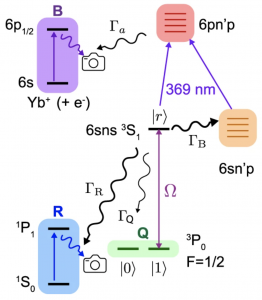
Knowing that eliminating qubit errors is not practical, Kolkowitz and colleagues instead asked if there might be a way to convert the errors into a type known as erasure errors. Named for the fact that the qubit has effectively vanished, or been erased, erasure errors can be beneficial because it is much easier to tell if a qubit is missing than if it is in the correct state or not.
They investigated the largely unstudied (in this context) element ytterbium because it has a relatively simple outer electron structure and its nucleus can only exist in two quantum spin states, +1/2 and -1/2. When manipulated into a metastable electronic state — a temporary state different than the true ground state — the qubit states are then set by the nuclear +1/2 and -1/2 spin states, and the quantum gates involve coupling one of these two qubit states to the Rydberg state.
“We knew that if an atom falls out of the metastable electronic state to the true ground state, we can detect that with a laser and still not screw up any of the other qubits at all,” Kolkowitz says. “But what that means is if I can set up a situation where errors manifest themselves as falling down into the ground state, I can just shine this laser and constantly check for errors and identify the qubit it happened in.”
In their first calculations using this metastable ytterbium platform, they showed that though errors still occur in the qubits as expected, around 98% of them would be converted to the detectable erasure errors.
But is that 98% error conversion rate good enough for a quantum computer in practice? The answer depends on the error threshold, a value that differs depending on the gates and qubits being used. The researchers next ran simulations of different numbers of quantum gates with a 98% erasure error conversion rate, or no conversion to erasure errors at all (as is currently standard).
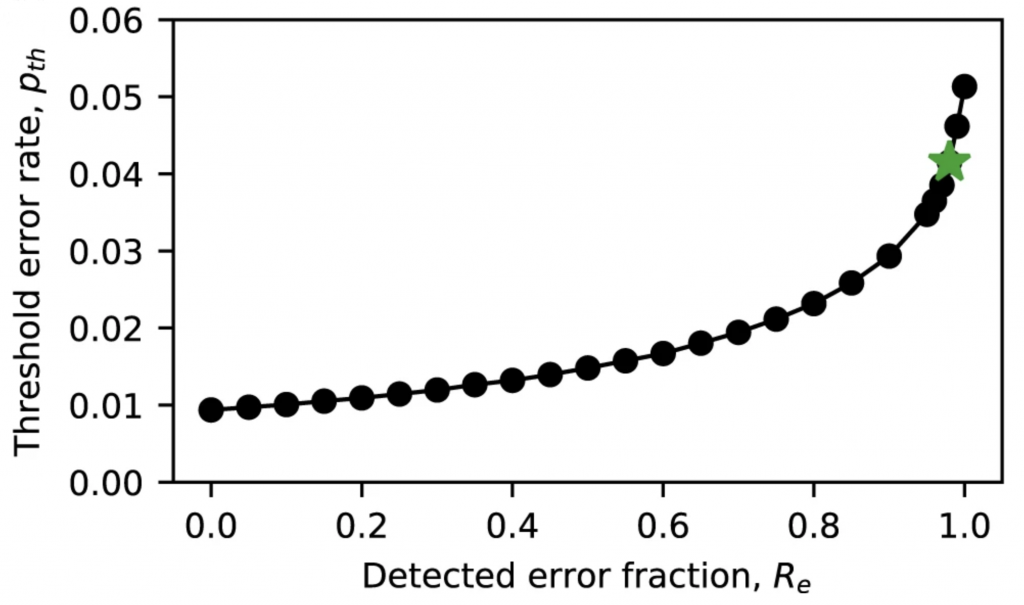
Without erasure error conversion, the error threshold is just shy of 1%, meaning each quantum gate would have to operate at over a 99% success probability to be fault tolerant. With erasure error conversion, however, the error threshold increases 4.4-fold, to just over 4%. And, for example, Saffman’s group has already demonstrated better than 4% error rates in neutral atom qubits.
The higher error threshold also means that there can be a higher ratio of logical qubits to physics qubits. Instead of one logical qubit per 1000 physical qubits, there could be around ten.
“And that’s the point of this work,” Kolkowitz says. “We show that if you can do this erasure conversion, it relaxes the requirements on both the error rates and on the number of atoms that you need.”
Co-author Jeff Thompson, an RQS investigator at Princeton, is already working to demonstrate these results experimentally in his lab. While other elements have been used in neutral atom quantum computing experiments before, until recently ytterbium was largely an unknown. Thompson’s group did much of the preliminary work to characterize the element and show that it could work well as the building block for a quantum computer.
“There were many open questions about ytterbium, and I’d say a lot of people who were using other elements are now moving into ytterbium based on Jeff’s groundwork,” Kolkowitz says. “And I expect that this study will accelerate that trend.”
Yue Wu and Shruti Puri at Yale University collaborated on this study. This work was supported by the National Science Foundation QLCI grants OMA-2120757 and OMA-2016136. Kolkowitz’s part of the work was additionally supported by ARO W911NF-21-1-0012.
Margaret Fortman awarded Google quantum computing fellowship
This post was adapted from a story posted by the UW–Madison Graduate School
Two UW–Madison graduate students, including physics grad student Margaret Fortman, have been awarded 2022 Google Fellowships to pursue cutting-edge research. Fortman received the 2022 Google Fellowship in Quantum Computing, one of only four awarded.
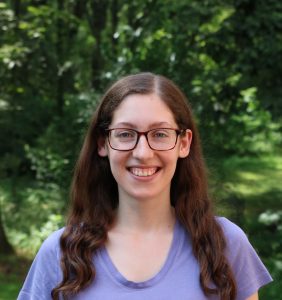
Google created the PhD Fellowship Program to recognize outstanding graduate students doing exceptional and innovative research in areas relevant to computer science and related fields. The fellowship attracts highly competitive applicants from around the world.
“These awards have been presented to exemplary PhD students in computer science and related fields,” Google said in its announcement. “We have given these students unique fellowships to acknowledge their contributions to their areas of specialty and provide funding for their education and research. We look forward to working closely with them as they continue to become leaders in their respective fields.”
The program begins in July when students are connected to a mentor from Google Research. The fellowship covers full tuition, fees, and a stipend for the academic year. Fellows are also encouraged to attend Google’s annual Global Fellowship Summit in the summer.
Fortman works to diagnose noise interference in quantum bits
Fortman, whose PhD research in Victor Brar’s group specializes in quantum computing, will use the fellowship support to develop a diagnostic tool to probe the source of noise in superconducting quantum bits, or qubits.
Quantum computing has the potential to solve problems that are difficult for standard computers, Fortman said, but the field has challenges to solve first.
“The leading candidate we have for making a quantum computer right now is superconducting qubits,” Fortman said. “But those are currently facing unavoidable noise that we get in those devices, which can actually come from the qubit material itself.”
Fortman works with a low-temperature ultra-high vacuum scanning tunneling microscope on the UW–Madison campus to develop a microscopic understanding of the origins of noise in qubits. She fabricates superconductors to examine under the microscope to identify the source of the noise, and hopefully be able to develop a solution for that interference.
In her time as a graduate student at UW–Madison, Fortman said she has enjoyed collaborating with colleagues in her lab and across campus.
“It’s pretty cool to be somewhere where world-renowned research is happening and to be involved with that,” she said. “My PI and I work in collaborations with other PIs at the university and they’re all doing very important research, and so it’s really cool to be a part of that.”
Fortman is excited to have a mentor at Google through the PhD Fellowship, having been paired with someone who has a similar disciplinary background and who is a research scientist with Google Quantum AI.
“He can be a resource in debugging some parts of my project, as well as general mentorship and advice on being a PhD student, and advice for future career goals,” Fortman said.
The second UW–Madison student who earned this honor is computer sciences PhD student Shashank Rajput, who received the 2022 Google Fellowship in Machine Learning.
The future of particle physics is also written from the South Pole
This post was originally published by the IceCube collaboration. Several UW–Madison physicists are part of the collaboration and are featured in this story
A month ago, the Seattle Community Summer Study Workshop—July 17-26, 2022, at the University of Washington—brought together over a thousand scientists in one of the final steps of the Particle Physics Community Planning Exercise. The meetings and accompanying white papers put the cherry on top of a period of collaborative work setting a vision for the future of particle physics in the U.S. and abroad. Later this year, the final report identifying research priorities in this field will be presented. Its main purpose is to advise the Department of Energy and the National Science Foundation on research for their agendas during the next decade.
As new and old detectors once again prepare to expand the frontiers of knowledge, we asked some IceCube collaborators about the role the South Pole neutrino observatory should play in the bright future that lies ahead for particle physics.
Q: What type of neutrinos are currently detected in IceCube? And will that change with the future extensions?
The vast majority of the neutrinos we detect are generated in the atmosphere by cosmic rays, but we also have on the order of 1,000 cosmic neutrinos at energies above 10 TeV. We use the atmospheric neutrinos for a wide range of science, first of all to study the neutrinos themselves.
IceCube has detected more than a million neutrinos to date. That’s already a big number for neutrino scientists, and we will detect even more in the future. The deployment of the IceCube Upgrade, an extension of our facility targeting neutrinos at lower energies, will increase the density of sensors in IceCube’s inner subdetector, DeepCore, by a factor of 10. And a second, larger extension is also in the works. With IceCube-Gen2, we will improve the detection at the highest energies, too: the IceCube volume will increase by almost a factor of 10, and our event rate for high-energy cosmic neutrinos will also grow by an order of magnitude.
Albrecht Karle, IceCube associate director for science and instrumentation and a professor of physics at the University of Wisconsin–Madison
Q: Are the futures of IceCube and that of particle physics intrinsically linked?
Absolutely! Many open questions in particle physics have neutrinos at the center. What’s their mass? What is the behavior of neutrino flavor mixing? Are there right-handed (sterile) neutrinos? Neutrinos are particularly attractive in the search for new physics. We can answer all these questions, to varying levels, within IceCube and especially moving forward with the IceCube Upgrade and IceCube-Gen2.
Erin O’Sullivan, an associate professor of physics at Uppsala University
IceCube, the Icecube Upgrade, and IceCube-Gen2 can all uniquely contribute to the study of particle physics, in particular, neutrino physics, beyond Standard Model (BSM) physics, and indirect searches of dark matter. The IceCube Upgrade provides complementary and independent measurements of neutrino oscillation in addition to the long-baseline experiments. And IceCube-Gen2 will be crucial to exploring the BSM features, such as sterile neutrinos and secret neutrino interactions, at an energy that cannot be reached by the underground facilities. It will also be a discovery machine for heavy dark matter particles.
Ke Fang, an assistant professor of physics at the University of Wisconsin–Madison
Q: Talking about discoveries, now that both IceCube and Super-Kamiokande have reported definitive observations of tau neutrinos in atmospheric and astrophysical neutrino data, why should the international particle physics community continue to improve their detection?
The tau neutrino was discovered at Fermilab in an emulsion experiment where they observed double-bang events with a distance on the order of 1 mm separating production and decay. Since they represent the least studied neutrino and, in fact, one of the least studied particles, improved measurements of tau properties may reveal that the 3×3 matrix is not unitary and expose the first indication of physics beyond the 3-flavor oscillation scenario.
Francis Halzen, IceCube PI and a professor of physics at the University of Wisconsin–Madison
We are the only experiment operating currently (and in the foreseeable future) that is able to identify tau neutrinos on an event-by-event basis. We can do so by looking at the distinct morphological features they produce in our data at the highest energies. And with the IceCube Upgrade, we will also be the experiment that collects the most tau neutrinos. I suspect that these neutrinos will surprise us again and point us towards new physics.
Carlos Argüelles, an assistant professor of physics at Harvard University.
Four hundred years from now, people may see IceCube the way we see Galileo’s telescope, not as an end but as the beginning of a new branch of science. The astrophysical observation of tau neutrinos is but one piece in a large number of studies that IceCube can conduct, including the study of fundamental physics using astrophysical neutrinos.
Ignacio Taboada, IceCube spokesperson and a professor of physics at the Georgia Institute of Technology
Q: In 2019, the Wisconsin IceCube Particle Astrophysics Center joined the Interactions Collaboration, which includes all major particle physics laboratories around the globe. The IceCube letter of introduction to this community detailed some of the most accurate results to date in neutrino physics. What’s unique about IceCube neutrino science?
One unique aspect of IceCube is the breadth of neutrino energy that we can measure, all the way down to the MeV energy scale in the case of a galactic supernova and up to as far as a few PeV neutrinos, which are the highest energy neutrinos ever detected. Therefore, IceCube provides us with different windows to study the neutrino and understand its properties. Especially in the context of searching for new physics, this is important as these processes can manifest at a particular energy scale but not be visible at other energy scales.
Erin O’Sullivan, an associate professor of physics at Uppsala University
Q: Let’s focus on high-energy neutrinos for a moment. What are the needs for their detection and why is the South Pole ice the perfect place for those searches?
The highest energy neutrinos can be directly linked to the most powerful accelerators in the universe but also allow us to test the Standard Model at energies inaccessible to current or future planned colliders.
And why the South Pole? Well, what makes the South Pole such an optimal location are the exceptional optical and radio properties of its ice sheet, which is also the largest pool of ice on Earth. Neutrino event rates are very low at these energies and, thus, we need a huge detector to measure them.
Deep-ice Cherenkov optical sensors have already been proven as high-performing detectors for TeV and PeV neutrinos when deployed at depths of 1.4 km and greater below the surface. And radio technology is promising because radio waves can travel much further than optical photons in the ice, plus they work at shallow depths. So, when searching for the highest energy neutrinos using the South Pole ice sheet, radio neutrino detectors might be the only solution that scales up. Radio waves are able to travel further in the South Pole than in Greenland, for example. It’s a gift from nature to have this giant, pure block of ice to catch elusive neutrinos from the most powerful accelerators.
Lu Lu, an assistant professor of physics at the University of Wisconsin–Madison
Q: And what about the lowest energies? How does IceCube perform there?
IceCube’s DeepCore detector was especially designed for that: a more dense layout of photodetectors embedded in the center of IceCube and located at about 2 km depth, it uses the surrounding IceCube sensors to eliminate essentially all background from the otherwise dominant cosmic ray muons. This means that DeepCore can now be analyzed as if it was at 10 km depth, deeper than any mine on Earth. In the near future, the IceCube Upgrade will add seven strings of new sensors inside DeepCore, which will hugely increase its precision for neutrino properties.
Albrecht Karle, IceCube associate director for science and instrumentation and a professor of physics at the University of Wisconsin–Madison
IceCube’s low energies are what all other neutrino experiments would call high energies. This is a regime where the neutrino interactions are well predicted from accelerator experiments, which means that if deviations are found in the data we can claim new physics. Thus, IceCube and the upcoming IceCub Upgrade results are not only going to yield some of the most precise measurements on the neutrino oscillation parameters but also—and more importantly—test the neutrino oscillation framework.
Carlos Argüelles, an assistant professor of physics at Harvard University
Q: And, last but not least, we should think about the people that will make all this possible. What efforts are underway to diversify who does science and make the field more equitable?
Four years ago, IceCube invited a few collaborations to join efforts to increase equity, diversity, inclusion, and accessibility (DEIA) in multimessenger astrophysics. With support from NSF, this was the birth of the Multimessenger Diversity Network (MDN). This network now includes a dozen participating collaborations, which is an indication of the growing awareness and action to increase DEIA across the field. Set up as a community of practice, where people share their knowledge and experiences with each other, the MDN is a reproducible and scalable model for other fields. We are excited to see this community of practice grow, to contribute with resources and experiences, and to learn from others.
For the first time in an official capacity, DEIA efforts were included in the Snowmass planning process and were also incorporated into the Astro2020 Decadal Survey. One take-away from these processes is that more resources and accountability are needed to speed up DEIA efforts.
Ellen Bechtol, MDN community manager and an outreach specialist at the Wisconsin IceCube Particle Astrophysics Center
Read more about IceCube and its future contributions to particle physics
- Snowmass Neutrino Frontier: NF04 Topical Group Report. Neutrinos from natural sources. (Jul 2022)
- CF7. Cosmic Probes of Fundamental Physics. Topical Group Report (Jul 2022).
- “High-Energy and Ultra-High-Energy Neutrinos: A Snowmass White Paper”, M.Ackermann et al. arxiv.org/abs/2203.08096
- “Tau Neutrinos in the Next Decade: from GeV to EeV,” R. S. Abraham et al. arxiv.org/abs/2203.05591
- “Snowmass White Paper: Beyond the Standard Model effects on Neutrino Flavor,” C. Argüelles et al. arxiv.org/abs/2203.10811
- “Snowmass 2021 White Paper: Cosmogenic Dark Matter and Exotic Particle Searches in Neutrino Experiments,” J. Berger et al. arxiv.org/abs/2207.02882
- “White Paper on Light Sterile Neutrino Searches and Related Phenomenology,” M. A. Acero et al, arxiv.org/abs/2203.07323
- “Ultra-High-Energy Cosmic Rays: The Intersection of the Cosmic and Energy Frontiers,” A. Coleman, arxiv.org/abs/2205.05845
- “Advancing the Landscape of Multimessenger Science in the Next Decade,” K. Engle et al. arxiv.org/abs/2203.10074